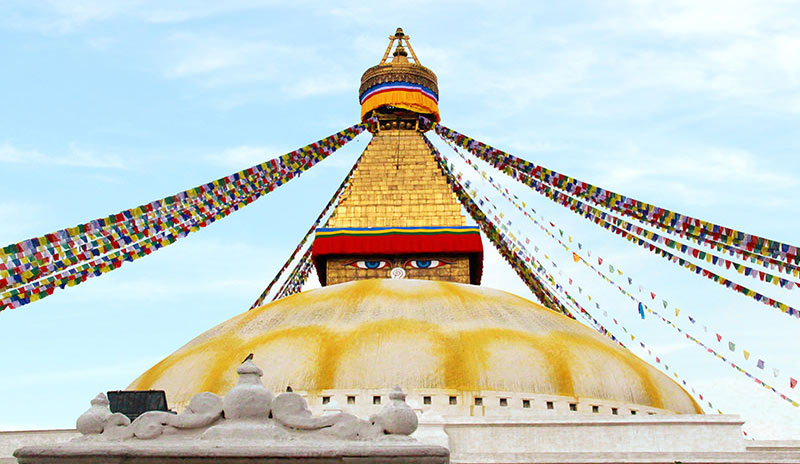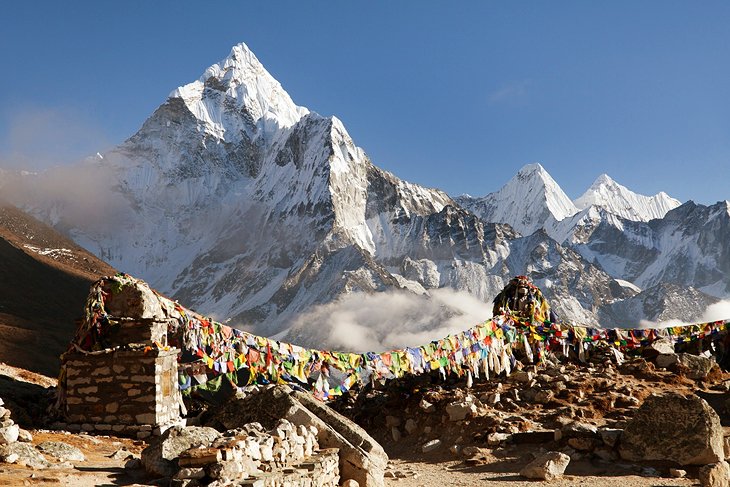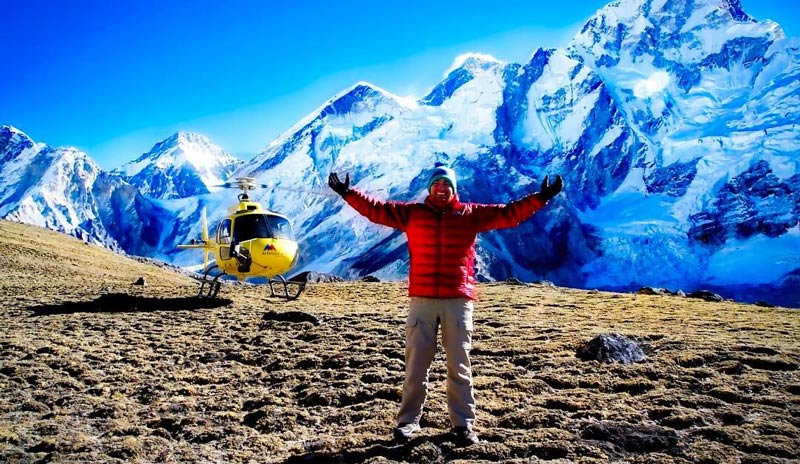Nepal, a fascinating country nestled in the Himalayas, is renowned for its stunning natural beauty, rich cultural heritage, and adventure opportunities. From the majestic Mount Everest, the highest peak in the world, to the vibrant city of Kathmandu with its ancient temples and bustling bazaars, Nepal offers a myriad of attractions that entice both nature lovers and culture enthusiasts.
The country’s distinct cuisine, warm hospitality, and spiritual traditions also contribute to its fame. So, whether you dream of conquering lofty mountains, immersing yourself in ancient traditions, or simply indulging in local delicacies, Nepal has something for everyone.
Mount Everest

Highest peak in the world
Mount Everest, standing tall at an impressive height of 8,848 meters (29,029 feet), is undeniably one of the most iconic landmarks in the world. As far as mountain peaks go, Mount Everest is the pinnacle of human achievement in conquering nature’s formidable challenge. Its majestic presence captures the imagination of adventure seekers and mountaineers from all corners of the globe.
Popular destination for mountaineers
For those seeking the ultimate mountaineering experience, Mount Everest is an irresistible calling. Year after year, climbers flock to Nepal with the dream of standing on top of the world. The treacherous ascent, limited weather windows, and extreme climate conditions contribute to the allure and mystique of this mighty peak. While the journey is undoubtedly arduous and demanding, the rewards are immeasurable – an overwhelming sense of accomplishment and panoramic vistas that extend beyond the realm of imagination.
Challenges and risks involved in climbing
Climbing Mount Everest is not for the faint-hearted. The daunting challenges and risks that climbers face are an inherent part of the Everest experience. From avalanches and treacherous icefalls to altitude sickness and extreme weather conditions, the mountain demands unwavering determination, physical endurance, and mental fortitude. The climbers must also contend with the infamous “death zone” above 8,000 meters, where oxygen levels are dangerously low, pushing the limits of human capability. A successful summit of Mount Everest is a testament to the indomitable spirit of those who dare to conquer the world’s highest peak.
Pashupatinath Temple
Sacred Hindu temple
Nestled on the banks of the holy Bagmati River in Kathmandu, the Pashupatinath Temple stands as a testament to the deep-rooted religious fervor of the Nepali people. Dedicated to Lord Shiva, the temple is one of the most sacred Hindu temples in the world. It attracts devotees from all over Nepal and beyond, who come to seek blessings and to pay homage to the mighty Lord Shiva, the destroyer and transformer in the Hindu pantheon.

Cremation site for Hindus
Pashupatinath Temple holds immense significance as a cremation site for Hindus. The rituals surrounding death and cremation are an integral part of Hindu culture and spirituality. The ghats (cremation platforms) on the banks of the Bagmati River witness the solemn cremation ceremonies, where the deceased are bid farewell to embark on their spiritual journey. This unique aspect of Pashupatinath Temple provides visitors with a profound insight into the importance of death, spirituality, and the cycle of life as perceived by the Hindu faith.
Importance during festivals
Pashupatinath Temple truly comes alive during various festivals and religious celebrations. Devotees in vibrant attire gather in large numbers to observe and participate in rituals and ceremonies that are deeply rooted in Nepali culture and tradition. Festivals such as Maha Shivaratri and Teej showcase the lively spirit and devotion of the Nepali people as they pay tribute to Lord Shiva and seek his blessings. The festive atmosphere permeates the air, and the temple becomes a vibrant hub of religious fervor and celebration.
Kathmandu Valley
Historical and cultural hub of Nepal
As the beating heart of Nepal’s rich cultural heritage, the Kathmandu Valley is an enchanting amalgamation of history, spirituality, and artistic grandeur. The valley comprises three ancient cities – Kathmandu, Bhaktapur, and Patan – that have witnessed the rise and fall of numerous dynasties and kingdoms. Each city boasts magnificent architecture, intricately carved temples, and palaces that bear witness to the artistic prowess of the Newar craftsmen.
UNESCO World Heritage Site
Recognizing the immense historical and cultural value of the Kathmandu Valley, UNESCO designated it as a World Heritage Site in 1979. This prestigious title reinforces the valley’s significance as a cultural gem that must be preserved for future generations. The temples, stupas, and palaces scattered throughout the valley are a testament to the rich and diverse religious traditions that have flourished in Nepal over the centuries.

Ancient temples and palaces
The Kathmandu Valley is home to a plethora of ancient temples and palaces, each with its own unique story to tell. The holy sites of Swayambhunath, Boudhanath, and Pashupatinath resonate with spiritual energy, drawing devotees and visitors alike. The magnificent Durbar Squares in Kathmandu, Bhaktapur, and Patan display architectural marvels that narrate the tales of the valley’s regal past. Exploring these historical sites allows you to delve into the rich tapestry of Nepal’s culture, art, and deep-rooted traditions.
Buddhism
Birthplace of Buddha
Nestled in the foothills of the Himalayas lies the sacred birthplace of Siddhartha Gautama, the revered teacher and founder of Buddhism. Lumbini, located in present-day Nepal, holds immense importance for Buddhists worldwide as the place where Prince Siddhartha was born and took his first footsteps towards enlightenment. It serves as a pilgrimage site for Buddhists, who come to pay their respects and find solace in the serenity of this holy place.
Numerous Buddhist sites and monasteries
Nepal is replete with numerous Buddhist sites and monasteries that dot its verdant landscape. From the iconic Boudhanath Stupa, one of the largest stupas in the world, to the serene tranquility of the Kopan Monastery, these spiritual landmarks offer a sanctuary of peace and introspection. Swayambhunath, often referred to as the Monkey Temple, is yet another cherished Buddhist site, perched atop a hill, commanding panoramic views of the Kathmandu Valley.
Influence on Nepali culture
The influence of Buddhism on Nepali culture runs deep. It has intricately woven its teachings and philosophies into the fabric of everyday life. The compassion, mindfulness, and meditation techniques advocated by Buddhism have permeated Nepali society, shaping the way people think, act, and relate to one another. The harmonious coexistence of multiple religious traditions in Nepal is a testament to the ethos of tolerance and acceptance fostered by the Buddhist principles.
Trekking

Himalayan treks like Annapurna, Langtang, etc.
Nepal’s majestic Himalayan range provides an awe-inspiring backdrop for trekkers and adventure enthusiasts. The country is blessed with numerous trekking routes, each with its own allure and breathtaking vistas. The Annapurna Circuit, nestled in the rugged beauty of the Annapurna Massif, is a popular choice for trekkers from around the world, offering a diverse range of landscapes – from lush forests and cascading waterfalls to barren high-altitude desert. The Langtang Valley trek, known as the “Valley of Glaciers,” rewards trekkers with stunning views of snow-capped peaks and insights into the unique Tamang culture.
Scenic beauty and diverse landscapes
Trekking in Nepal is a visual feast for the senses. Every step unravels the diverse landscapes that Nepal has to offer – from lush rhododendron forests and shimmering glacial lakes to towering mountains and serene alpine meadows. The pristine beauty of the Himalayas is complemented by the warmth and hospitality of the local communities that welcome trekkers with open arms. Connecting with nature and immersing yourself in the stunning surroundings is a transformative experience that cannot be replicated elsewhere.
Tea houses and local culture
Along the trekking routes, tea houses serve as welcome havens for weary trekkers, offering warm meals, comfortable beds, and a chance to connect with fellow adventurers. These quaint lodges are not just a place to rest and rejuvenate; they also provide a glimpse into the vibrant local culture and way of life. Interacting with the locals, experiencing their customs and traditions, and savoring local delicacies is an integral part of the trekking experience. The hospitality and genuine warmth of the Nepali people leave an indelible mark on the hearts of trekkers.
Lumbini
Birthplace of Buddha
Lumbini, a humble town in the southern plains of Nepal, holds immense significance as the birthplace of Siddhartha Gautama, who would later become known as the Buddha. The sacred Mayadevi Temple marks the exact spot where the prince was born. Pilgrims flock to Lumbini from all corners of the world to pay homage to the enlightened one, to meditate in the serene gardens, and to gain spiritual insight from the ancient ruins that surround the town.

Pilgrimage site for Buddhists
For Buddhists worldwide, Lumbini is considered one of the most sacred pilgrimage sites. It is a place of profound reverence, where one can connect with the essence of Buddhism and bask in the serene ambience that envelops the birthplace of the enlightened one. Monastic complexes, prayer flags, and meditation centers provide pilgrims with the opportunity to deepen their understanding and practice of Buddhist teachings, nourishing their spiritual journey.
UNESCO World Heritage Site
Recognizing the historical and cultural significance of Lumbini, UNESCO designated it as a World Heritage Site in 1997. This prestigious title not only underscores the universal value of Lumbini but also reinforces the need for its preservation and protection. As visitors explore the sacred sites, ancient ruins, and beautifully landscaped gardens, they can experience the timeless wisdom and peace that emanate from this hallowed ground.
Yak
Symbol of the Himalayas
The yak, with its hardy constitution and majestic presence, has become an enduring symbol of the Himalayas and its rugged terrain. These magnificent creatures are uniquely adapted to survive in the harsh mountain environment, with their thick fur, large lungs, and incredible climbing abilities. The sight of these powerful animals grazing in vast meadows against the backdrop of towering peaks adds to the allure and mystique of the Himalayan landscape.
Used as pack animals in mountain areas
For centuries, yaks have been indispensable companions to the people residing in the mountainous regions of Nepal. Their robust physique and surefootedness make them ideal pack animals for transporting goods and supplies across treacherous terrains. The yaks play a vital role in maintaining the livelihoods of the locals, ensuring that essential provisions reach even the most remote corners of the Himalayas. Their unwavering strength and resilience earn them a special place in the hearts of the Nepali people.
Their milk and hair
Yaks contribute to the sustenance of local communities not just as carriers but also as a source of valuable resources. Yak milk is highly nutritious and constitutes an essential part of the local diet, providing sustenance in the form of milk, butter, and cheese. The thick hair of yaks, known as yak wool, is harvested to create warm and durable clothing, blankets, and rugs that help withstand the extreme cold of the Himalayan winters. This utilization of the yak’s natural resources exemplifies the harmonious relationship between humans and animals in the Himalayan ecosystem.
Gorkha Warriors
Renowned Nepali warriors
The Gorkhas, with their indomitable spirit, unparalleled bravery, and exceptional military skills, have earned a formidable reputation as renowned warriors hailing from the hills of Nepal. Their legacy of courage and loyalty stretches back centuries, with tales of their valor echoing through the annals of history. The Gorkhas’ distinguished military service, loyalty, and unwavering dedication have earned them respect and admiration not just in Nepal but also in the countries they have served.
Known for bravery and military skills
The Gorkha Warriors are renowned for their unmatched bravery and military prowess. Their combat skills and unwavering determination have made them formidable opponents on the battlefield, earning accolades and admiration from allies and adversaries alike. The legendary kukri, a crescent-shaped knife wielded with deadly precision, symbolizes their fearsome prowess and tenacity in the face of adversity. The Gorkhas’ unmatched martial traditions continue to inspire and forge a deep sense of national pride.
Legacy and impact on Nepali history
The Gorkhas’ impact on Nepali history cannot be overstated. From their significant role in unifying fragmented regions of Nepal under the Shah dynasty to their valiant service in the British Indian Army and beyond, the Gorkhas have left an indelible mark on the nation’s collective consciousness. Their legacy of bravery and military excellence continues to inspire future generations, fostering a sense of courage, resilience, and national unity among the Nepali people.
Thamel
Vibrant tourist hub in Kathmandu
Thamel, located in the heart of Kathmandu, holds the distinction of being the city’s vibrant and bustling tourist hub. Its narrow streets, lined with an eclectic mix of shops, restaurants, and hotels, teem with tourists and locals alike, creating a vibrant atmosphere that is uniquely Thamel. It is a melting pot of cultures, languages, and cuisines, where travelers can immerse themselves in the intriguing tapestry of Kathmandu’s multicultural charm.
Wide range of shops, restaurants, and hotels
Thamel offers an extensive range of shops that cater to every whim and fancy of the discerning traveler. From handicrafts and souvenirs that reflect Nepal’s rich artistic heritage to mountaineering gear and outdoor equipment for the adventure enthusiasts, Thamel’s shops leave no stone unturned in meeting the diverse needs of its visitors. The plethora of restaurants and cafes in Thamel introduces travelers to a world of flavors, ranging from traditional Nepali cuisine to international delicacies that tantalize taste buds.
Nightlife and entertainment
When the sun sets, Thamel transforms into a vibrant hub of nightlife and entertainment. The lively bars, clubs, and live music venues come alive, setting the stage for unforgettable evenings of revelry and merriment. Whether you choose to dance the night away, engage in stimulating conversations with fellow travelers, or simply soak in the electrifying atmosphere, Thamel offers an array of options that cater to various tastes and preferences. It is the perfect place to celebrate the thrill of adventure or wind down after an exhilarating day exploring the wonders of Nepal.
Momo
Traditional Nepali dumplings
No journey to Nepal is complete without savoring the delectable delights of momo, a mouth-watering culinary masterpiece that has become synonymous with Nepali cuisine. These delicious dumplings are typically filled with a delightful combination of minced meat or vegetables, wrapped in delicate dough, and steamed or fried to perfection. The burst of flavors and the irresistible aroma make momo a favorite street food and a must-try dish for visitors to Nepal.
Popular street food
Momo’s popularity as a street food has transcended national boundaries, captivating taste buds across the globe. In the narrow alleys of Kathmandu or tucked away in bustling markets, you will find street vendors skillfully sculpting these bite-sized delicacies. The sight of steam rising from the momo carts and the tantalizing sounds of sizzling dumplings create a sensory symphony that draws in locals and tourists alike. Grabbing a plate of piping hot momo and savoring its deliciousness is an experience that will leave you craving more.
Different fillings and varieties
One of the joys of indulging in momo is the wide range of fillings and varieties available to suit every palate. From succulent chicken or tender buffalo to vegetarian options bursting with garden-fresh vegetables, momo offers something for everyone. The subtle blend of herbs and spices used in the filling, coupled with the tangy dipping sauce, adds an explosion of flavors that will tantalize your taste buds. Whether you prefer steamed, fried, or even jhol (served in a flavorful soup), the versatility of momo ensures that there is always a new variation to explore and relish.
With its majestic peaks, cultural heritage, and warm hospitality, Nepal has earned a place as a bucket list destination for adventurers, spiritual seekers, and lovers of nature alike. From the allure of Mount Everest to the serenity of Lumbini, Nepal offers a multitude of experiences that leave a lasting impression on the hearts and minds of those who visit.
Whether you seek the pinnacle of mountaineering glory, a spiritual awakening, or an authentic cultural experience, Nepal beckons you with open arms. Embrace the wonders that await and embark on a journey that will stay with you long after you have bid farewell to the land of the Himalayas.

